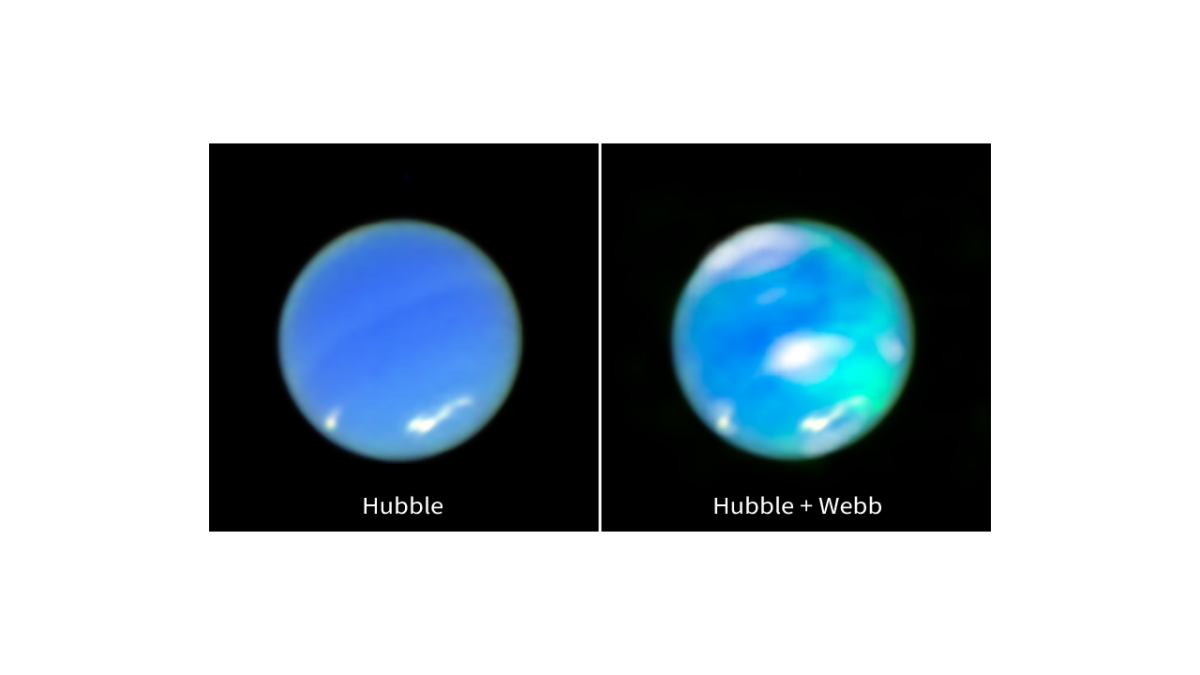FRISCO, TX — On March 26, 2025, the James Webb Space Telescope (JWST) identified Neptune’s awe-inspiring auroras, with hints of ultraviolet light when the Voyager 2 spacecraft flew by. This premier space science observatory is an international program led by the National Aeronautics and Space Administration (NASA) with the European Space Agency (ESA) and the Canadian Space Agency (CSA). NASA released these pictures on March 26, 2025, which were subsequently published in Nature Astronomy.
Previously hypothesized in 1989, Neptune’s auroras were discovered later than planets like Jupiter and Mercury due to its temperatures cooling by several hundred degrees in its upper regions.
“Neptune has always been elusive,” said University of Reading planetary scientist James O’Donoghue, co-author of the new study. Its auroras “had only been seen by Voyager, and we’ve been trying to see it again ever since.”
Auroras’ beauty comes from electrically charged molecules colliding with other molecules to form reactions that create light. According to the Webb Space Telescope, energetic particles, usually originating from the Sun, get trapped in a planet’s magnetic field and gradually strike the ionosphere (the upper atmosphere) and magnetosphere (where solar wind interacts with the magnetic field).
Unlike Earth’s auroras near the poles, Neptune’s auroras are at the planet’s geographic mid-latitudes. Earth and some of Jupiter’s moons have auroras that can be seen in visible light, Mercury has auroras that shine in X-ray light, and hydrogen-dominated planets like Jupiter, Saturn, and Uranus have aurorae that shine in the infrared or ultraviolet spectrum.
According to eos.org, planets with gas-dominated atmospheres have “aurorae [that] typically glow in the infrared or ultraviolet and are traced by the presence of the trihydrogen cation (H3+),” meaning planets like Jupiter, Saturn, Uranus, and Neptune that are made up of gas have auroras occur that glow in wavelengths above or with more energy than visible light.
“Turns out, actually imaging the auroral activity on Neptune was only possible with Webb’s near-infrared sensitivity,” said lead author Henrik Melin of Northumbria University, who conducted the research while at the University of Leicester. “It was so stunning to not just see the auroras, but the detail and clarity of the signature… shocked me.”
Scientists not only gained pictures of the auroras but also a spectrum to characterize the composition and measure the temperature of the ionosphere. Scientists discovered a highly noteworthy emission line representing the trihydrogen cation’s (H₃⁺) presence in the auroras created.
Webb Interdisciplinary Scientist and Guaranteed Time Observation program Leader, Heidi Hammel, of the Association of Universities for Research in Astronomy, explained the discovery’s significance.
“H₃⁺ has… been a clear signifier on all the gas giants — Jupiter, Saturn, and Uranus — of auroral activity, and we expected to see the same on Neptune as we investigated the planet over the years with the best ground-based facilities available,” said Hammel. “Only with a machine like Webb have we finally gotten that confirmation.”
Now, researchers are looking at the next steps of studying Neptune using JWST over a full 11-year solar cycle driven by the Sun’s magnetic field. Results may provide insight into the origin of Neptune’s magnetic field, explain its strange tilt, and help researchers understand how the planet’s magnetosphere responds to levels of solar activity.
“As we look ahead and dream of future missions to Uranus and Neptune, we now know how important it will be to have instruments tuned to the wavelengths of infrared light to continue to study the auroras,” added Leigh Fletcher of Leicester University, co-author of the paper. “This observatory has finally opened the window onto this last, previously hidden ionosphere of the giant planets.”
Additionally, researchers can gain further insight into Neptune’s cooling, which is faster than Neptune’s seasonal timescale of approximately 41 Earth years, and create models of the solar system’s auroras and further explore the ionosphere.
“It’s great to see this addition to the family portrait of solar system auroras,” said Planetary Aurora Researcher at the University of Leicester in the United Kingdom, Jonathon Nichols. “Now we know how bright the infrared emission is, we can work out the intensity in other wavelengths, such as ultraviolet, and we can run models to see what the upper atmosphere is like.”
An impactful discovery for astronomers, Neptune’s auroras provide a sea of possibilities for further exploration of the solar system while reflecting the quality of technological advancements with JSWT’s high-quality pictures. The vibrant light displays represent beauty found in the unknown and the mysteries of Neptune, illuminating the scientific research ahead.















